6 Common Causes of Flat Roof Leaks
Mar 21,2018

Like any roof, in time, after wear and tear and weathering, flat roofs will eventually leak. No roof will last forever and if you have a roof over your head it will most likely leak someday. This is perhaps all the more true of flat roofs, because water doesn’t run off of the roof surface quickly and can easily find breaks in the roofing surface resulting in leaks. Flat roofs are a common feature in many commercial or industrial buildings and often require more work than any other standard types of roofs. Though flat roofs are simple to build, it requires a lot of maintenance and inspection so that everything is functioning as it should.
If you own a commercial property with a flat roof, it can be daunting task to diagnose and resolve a problem if you suspect leakage. Leaks don’t always mean that your entire roof needs to be replaced. The most common and most challenging part of dealing with flat roof issues is figuring out whether you need to get it replaced or if it just needs a few minor repairs. If you notice a leak in your commercial flat roof, call Royal Roofing Ltd. for a complete roof inspection. We will diagnose leaks and repair your roof as necessary.
Common Problems that Can Cause Leaks in Flat Roofs
Flat commercial roofs are more complex than they might seem. There are several common causes for flat roof leaks, and each of them can occur in various situations:
Standing water on the roofing surface
Roof is located in a harsh environment
Utilizing outdated roofing technology
We’ve put together a list of common problems that occur in flat roofs and how to deal with the issues below:
Ponding Water
Standing or "ponding" water is one of the most common issues faced by flat roofs. It is characterized as any water that remains on the roof for longer than 48 hours following precipitation. The longer the water remains on your roof, the greater the chances are that it will lead to damaging leaks. The roof should be designed with a slight slope so that water can easily find its way to the drain points. Sometimes we find that even flat roofs that were carefully designed in this way can eventually be faced with ponding as they age.
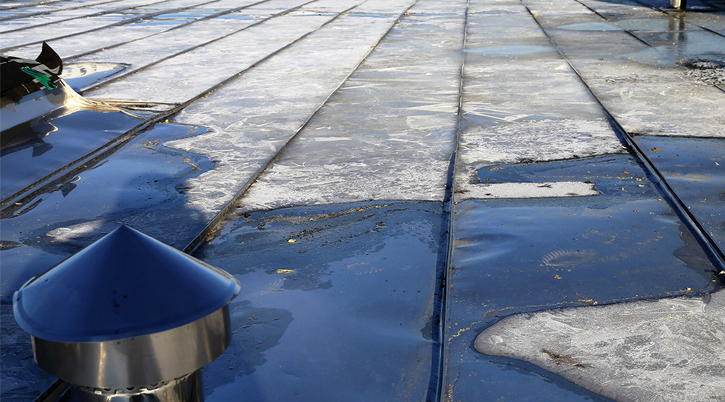
It is important that you regularly monitor your roof for any signs of standing water. Gutters, downspouts, wall scuppers and drains will lead to ponding if not functioning properly. Ponding is more likely to occur around large rooftop units because the weight of these structures will prevent the structure of the underlying roofing supports from working as designed, leading to ponding.
Be aware that, even if ponding doesn’t lead to leaks, it still represents a significant roofing problem. The reason for this is, as time goes by,the enormous weight of standing water will gradually make the problem worse. Roof leveling can resolve minor drainage issues, but more serious issues of ponding require changes to the underlying roof structure itself.
Leaks and Moisture
Another common problem with flat roofs is leaks. But since it’s a flat roof, the water doesn’t have anywhere to go but straight down. This means that the moisture can seep into the roof that may cause mold and fungus, or damage to the structure. The best way to overcome this issue is to get your roof inspected regularly so that it can be maintained every time there is an issue.
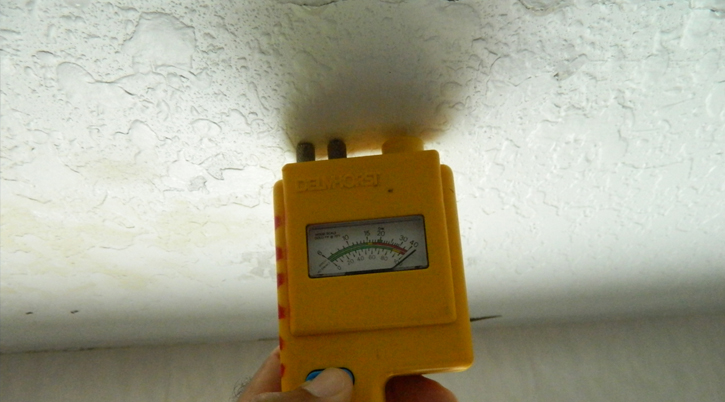
Damaged Roofing Membranes
Until several years ago, flat roofs were made of multiple layers of asphalt tar, roofing felt and gravel. This was an effective approach, but is time-consuming to install. So, nowadays, roofing membranes are the more popular choice of the business owners. These membranes are made of a very thin single-ply membrane, generally made of durable rubber. In comparison to built-up roofing these membranes are less expensive and easier to install.
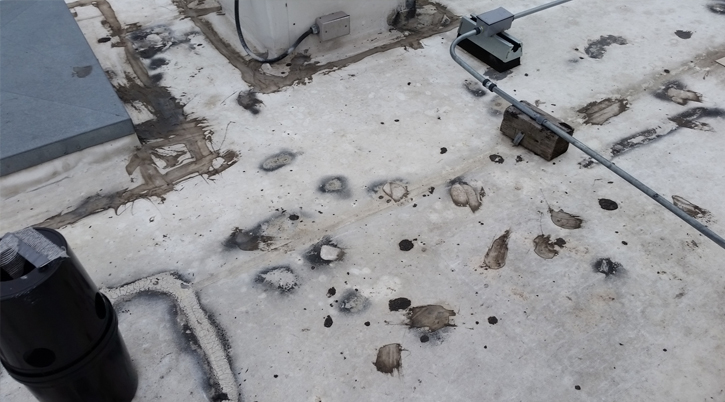
But, like any other roofing system, these membranes are prone to damage as time goes by. Cracks, blisters, and splits are some common problems. These cracks and splits allow water to accumulate beneath the membrane and once the insulation becomes waterlogged, it will lead to difficult to identify causes of leaks. For this reason, you should get your roofing membrane inspected regularly for signs of damage.
Cracks in the Roof
Flat roofs tend to have more pressure exerted in comparison to sloped/slanted roofs. When this pressure becomes excessive, it can lead your roof to crack. As soon you see any crack in the roof, call a commercial roofing contractor immediately. Not only will a crack will expose the roof structure - or potentially even the interior of building - to precipitation, but it is also a sign that your roof is structurally compromised and it’s the right time to get it repaired or replaced.
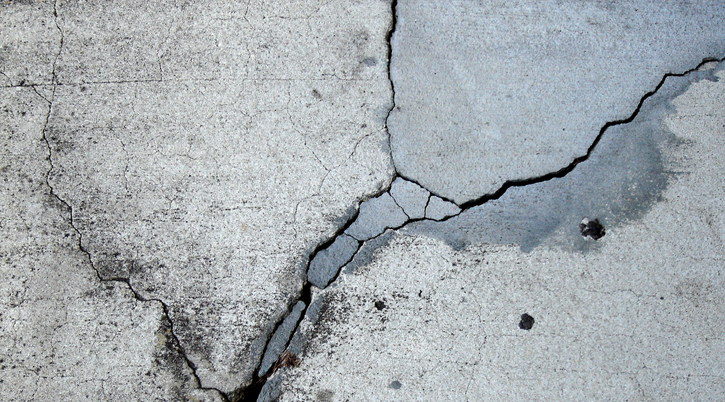
Flashing
Like most other materials, asphalt flat roofs expand and contract with changing weather. With time, this continued process of expansion and contraction will cause the flashing to pull away from the corners and edges of your roof. The flashing faults will lead to leaks, and moisture can easily get trapped inside the roof. The best way to avoid this is to get your flat roof inspected regularly and repaired as necessary, because if the leaks become significant you will have no other choice except to get a new roof.
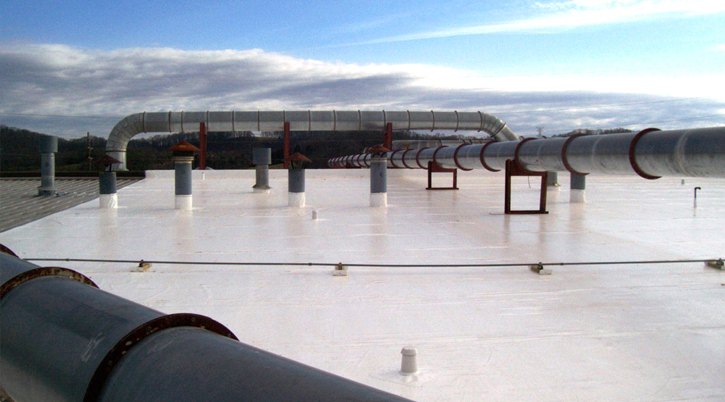
Roof Penetrating Structures
Flat roofs are vulnerable to leaks anywhere a structure rises up through the surface of the roof. These structures include gas lines, pipes, plumbing vents and other building elements. If you want to protect these features against leaks, different tactics can be used like rain collars, installation of flashing, field wraps, and pipe boots. Regular roofing inspections should be made for thorough check of all roof penetrating structures.
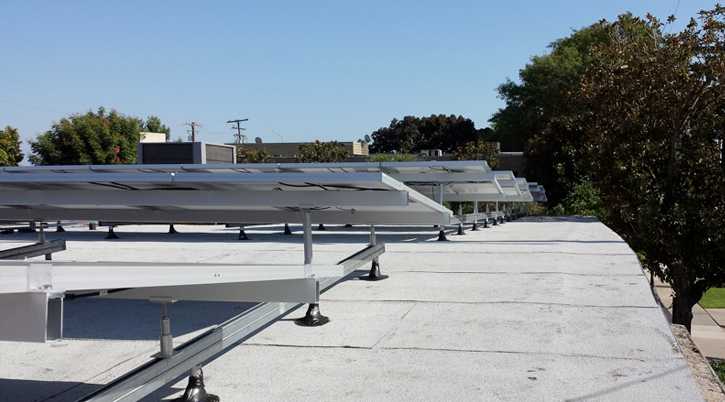
Sometimes it’s Not the Roof
Skylights are designed to be both attractive and functional, and are common features on industrial and commercial buildings. Sometimes the sealant in skylight assemblies will dry out as they age and separate from the curbs or panels. The water coming in from these leaks will be mistaken as roof leak, even though the fault is not in the roof, but rather in the skylight. For this reason, you should always get your roof inspected by a professional.
We at Royal Roofing Ltd. will visit your property and conduct a full inspection, including all aspects of the roof, as well as skylights and any other structures integrated with the roof. Our team of trained roofers can also use infrared technology to detect hidden moisture.
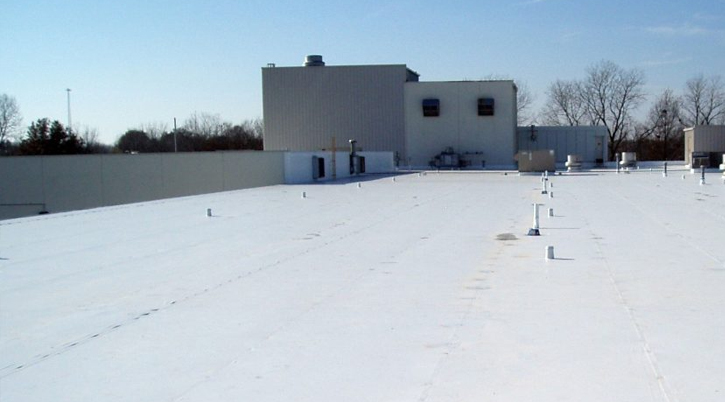
Call Royal Roofing Ltd. for Commercial Roof Repair or Inspections
Whether you need a commercial roofing contractor for the roof repair or simply want to know the true condition of your industrial or commercial flat roof, contact Royal Roofing Ltd. at 403-248-6397. We’re located in Calgary, Canada, and serve Saskatoon, Calgary, and nearby areas. Schedule your inspection or leak repair estimate today.


 It is important that you regularly monitor your roof for any signs of standing water. Gutters, downspouts, wall scuppers and drains will lead to ponding if not functioning properly. Ponding is more likely to occur around large rooftop units because the weight of these structures will prevent the structure of the underlying roofing supports from working as designed, leading to ponding.
Be aware that, even if ponding doesn’t lead to leaks, it still represents a significant roofing problem. The reason for this is, as time goes by,the enormous weight of standing water will gradually make the problem worse. Roof leveling can resolve minor drainage issues, but more serious issues of ponding require changes to the underlying roof structure itself.
It is important that you regularly monitor your roof for any signs of standing water. Gutters, downspouts, wall scuppers and drains will lead to ponding if not functioning properly. Ponding is more likely to occur around large rooftop units because the weight of these structures will prevent the structure of the underlying roofing supports from working as designed, leading to ponding.
Be aware that, even if ponding doesn’t lead to leaks, it still represents a significant roofing problem. The reason for this is, as time goes by,the enormous weight of standing water will gradually make the problem worse. Roof leveling can resolve minor drainage issues, but more serious issues of ponding require changes to the underlying roof structure itself.

 But, like any other roofing system, these membranes are prone to damage as time goes by. Cracks, blisters, and splits are some common problems. These cracks and splits allow water to accumulate beneath the membrane and once the insulation becomes waterlogged, it will lead to difficult to identify causes of leaks. For this reason, you should get your roofing membrane inspected regularly for signs of damage.
But, like any other roofing system, these membranes are prone to damage as time goes by. Cracks, blisters, and splits are some common problems. These cracks and splits allow water to accumulate beneath the membrane and once the insulation becomes waterlogged, it will lead to difficult to identify causes of leaks. For this reason, you should get your roofing membrane inspected regularly for signs of damage.




